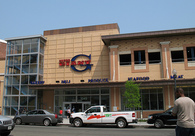
With hunger spreading across America at levels unseen since the Great Depression and with low-income urban communities continuing to be disproportionately affected by a lack of access to healthy food, many are asking questions about the best way to reach communities without adequate food sources.
One option that has been tried in many places, including Washington, DC, is to use tax incentives to lure food stores into seemingly “less desirable” neighborhoods. However, these incentives’ effectiveness depends on how and where they are applied.
Currently, in DC, a decade-old tax incentive that was originally intended to encourage new supermarkets to open in the city’s most economically depressed neighborhoods is drawing criticism. The DC Council recently passed legislation (introduced by Jim Graham) to extend this tax break to Ellwood Thompson’s, a high-end organic grocery store that is moving into the rapidly-gentrifying Columbia Heights neighborhood.
With a Giant supermarket a block away and a food section in the neighboring Target superstore, this wouldn’t seem to honor the original intention for the tax incentive to increase access to healthy food in DC’s poorest neighborhoods.
Ten years ago, when the incentive was first authorized and the current development boom in DC was in its infancy, Columbia Heights and similar neighborhoods would have indeed been considered food deserts. But as we all know, a lot has changed in DC since then. Meanwhile, DCFPI pointed out that the tax incentive has largely been ineffective at stimulating new groceries in areas that remain underserved.
But we can look to another example of a city offering this kind of incentive: the recently-passed Food Retail Expansion to Support Health (FRESH) initiative in New York City. In addition to tax breaks, the FRESH initiative offers companies zoning incentives to move into approved FRESH neighborhoods, such as not requiring as much parking as other retail stores must have. Because the New York model is based on newer data and reflects current food needs (rather than the needs of neighborhoods ten years ago, like in DC), there is a great opportunity for these incentives to benefit the communities they are intended for.
If incentives are going to be continued here in DC, the geographic restrictions that govern which communities receive these benefits must be changed to reflect current economic conditions in the city. Some organizations in DC are already working on an alternative to having grocery stores be the sole purveyor of fresh produce. For example, DC Hunger Solutions’ Healthy Corner Store Initiative is providing assistance to corner stores in Wards 7 and 8 to help them begin carrying farm fresh fruits and vegetables, thus increasing access to healthy food for some of the city’s neediest residents.
But it seems like the real question we need to answer here in DC is what will it take to bring full-service grocery stores — let alone an Ellwood Thompson — to Barry Farm or Anacostia? Incentives offered by the DC government for the last decade clearly haven’t been enough. It’s time to find a new solution.
Cross-posted at DC Food for All.
Top image: Giant in Columbia Heights. Photo by Mr. T in DC.
